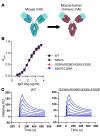Human IgG Fc domain engineering enhances antitoxin neutralizing antibody activity
- PMID: 24401277
- PMCID: PMC3904629
- DOI: 10.1172/JCI72676
Human IgG Fc domain engineering enhances antitoxin neutralizing antibody activity
Abstract
The effector activity of antibodies is dependent on engagement with Fcγ receptors (FcγRs) and activation of the associated intracellular signaling pathways. Preclinical evaluation of therapeutic humanized or chimeric mAbs to study the interactions of their Fc regions with FcγRs is hampered by substantial structural and functional FcγR diversity among species. In this report, we used mice expressing only human FcγRs to evaluate the contribution of FcγR-mediated pathways to the neutralizing activity of an anti-anthrax toxin chimeric mAb. We observed that the protective activity of this mAb was highly dependent upon FcγR engagement, with minimal protection against anthrax toxin observed in FcγR-deficient mice following mAb administration. We generated anti-anthrax toxin mAbs with specific Fc domain variants with selectively enhanced affinity for particular human FcγRs and assessed their activity in FcγR-humanized mice. We determined that Fc domain variants that were capable of selectively engaging activating FcγRs substantially enhanced the in vitro and in vivo activity of anthrax toxin-neutralizing antibodies. These findings indicate that the application of Fc domain engineering is a feasible strategy to enhance toxin-neutralizing activity and suggest that engineered antitoxin antibodies will have improved therapeutic efficacy.
Figures



Similar articles
-
An engineered Fc variant of an IgG eliminates all immune effector functions via structural perturbations.Methods. 2014 Jan 1;65(1):114-26. doi: 10.1016/j.ymeth.2013.06.035. Epub 2013 Jul 17. Methods. 2014. PMID: 23872058
-
Crystal structure of a novel asymmetrically engineered Fc variant with improved affinity for FcγRs.Mol Immunol. 2014 Mar;58(1):132-8. doi: 10.1016/j.molimm.2013.11.017. Epub 2013 Dec 14. Mol Immunol. 2014. PMID: 24334029
-
Broadly neutralizing hemagglutinin stalk-specific antibodies require FcγR interactions for protection against influenza virus in vivo.Nat Med. 2014 Feb;20(2):143-51. doi: 10.1038/nm.3443. Epub 2014 Jan 12. Nat Med. 2014. PMID: 24412922 Free PMC article.
-
Anti-retroviral antibody FcγR-mediated effector functions.Immunol Rev. 2017 Jan;275(1):285-295. doi: 10.1111/imr.12482. Immunol Rev. 2017. PMID: 28133801 Free PMC article. Review.
-
Structural analysis of Fc/FcγR complexes: a blueprint for antibody design.Immunol Rev. 2015 Nov;268(1):201-21. doi: 10.1111/imr.12365. Immunol Rev. 2015. PMID: 26497522 Review.
Cited by
-
Immunomic Investigation of Holocyclotoxins to Produce the First Protective Anti-Venom Vaccine Against the Australian Paralysis Tick, Ixodes holocyclus.Front Immunol. 2021 Oct 4;12:744795. doi: 10.3389/fimmu.2021.744795. eCollection 2021. Front Immunol. 2021. PMID: 34671357 Free PMC article.
-
Functional diversification of IgGs through Fc glycosylation.J Clin Invest. 2019 Sep 3;129(9):3492-3498. doi: 10.1172/JCI130029. J Clin Invest. 2019. PMID: 31478910 Free PMC article. Review.
-
Enrichment of high affinity subclasses and glycoforms from serum-derived IgG using FcγRs as affinity ligands.Biotechnol Bioeng. 2018 May;115(5):1265-1278. doi: 10.1002/bit.26545. Epub 2018 Feb 1. Biotechnol Bioeng. 2018. PMID: 29315477 Free PMC article.
-
Type I and type II Fc receptors regulate innate and adaptive immunity.Nat Immunol. 2014 Aug;15(8):707-16. doi: 10.1038/ni.2939. Nat Immunol. 2014. PMID: 25045879 Free PMC article. Review.
-
Quantum leap of monoclonal antibody (mAb) discovery and development in the COVID-19 era.Semin Immunol. 2020 Aug;50:101427. doi: 10.1016/j.smim.2020.101427. Epub 2020 Nov 17. Semin Immunol. 2020. PMID: 33277154 Free PMC article. Review.
References
Publication types
MeSH terms
Substances
Grants and funding
LinkOut - more resources
Full Text Sources
Other Literature Sources
Molecular Biology Databases

